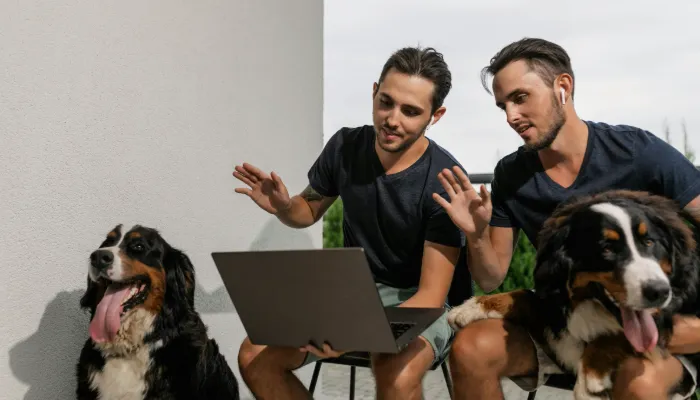Did you ever ask yourself, “how do you say “Hi” in dog language?” The body patterns, sounds, and actions that serve as greetings are unlike anything orchestrated by any human. Every canine has a distinct way to vocalize greetings, and that’s what we’ll investigate today.
By reading this post, you will learn how dogs communicate with their owners and the message they are trying to convey whenever they say “Hello”. Just as we have translators for languages, Here we have the dog translator. knowing what your dog is trying to communicate will certainly strengthen your relationship with your pet.

Understanding Dog Greetings
Canines do not greet by barking; instead, they use their mouths, tails, body posture, ears, and eyes to show their greetings. As you enter a room, you may start to think, “How Do You Say “Hi” in Dog Language?” With such tools available, they can convey much more than we can imagine, but it is crucial to pay close attention for better understanding.
Knowing such can assist in building strong bonds. You will appreciate the relationship with your dog more if you understand how dogs speak; therefore, you can reciprocate affection and compassion.
1. Wagging the Tail
Besides barking, tail wagging is one of the most common ways dogs say “Hello”. Nonetheless, monotonous tail movements are boring. Dogs use tail wagging as a tool to display their emotions.
- Fast Wagging: The tail going up and down continuously signifies happiness.
- Slow Wagging: Slow and careful tail movement can represent caution or meeting new people.
- Side-to-Side Wag: Side-to-side full-body tail movement often portrays extreme excitement.
- Stiff Wagging: Tension or nervousness is often portrayed from the tail getting stiff and wagging becoming rigid.
Wagging of the tail is one of the first signs of a dog’s joy and excitement. Regardless of speed, a wag is a done sign of greeting. Understanding the type of tail movement helps understand a dog’s mood properly.
2. Play Bow
Dogs say “Hi” in their own unique ways, and one common way is to play bow. In this position, a dog’s body lowers its front half while the back half is still standing, along with its legs extended in front of it.
- What It Means: It is a clear method that shows a dog’s willingness to play or engage with other animals and people, so the play bow position shows that the dog wants to interact and have fun as well.
- When It Happens: Many dogs tend to make this gesture when they come across other dogs or people, showing them that they are willing to play with them and have fun.
When your dog does this, you can be assured it’s a reliable signal of a dog’s friendly intentions. It’s likely your dog wants to engage or bond with you or someone who is nearby.
3. Eye Contact and Soft Gaze
Dogs see the eye as a reliable way to communicate their feelings, which is why when their eyes are relaxed and faces soft, it’s their way of saying ‘Hi.’ Soft eye contact can also just mean someone is fond of you and is only trying to greet you.
- What it Means: Gentle eye contact accompanied by a relaxed face shows the dog is relaxed around you and trusts you.
- How It Feels: It is like a loving attentive salutation.
Understanding dog greetings can deepen the bond between you and your furry friend. By paying attention to their tail wags, body posture, and facial expressions, you’ll learn how to better interpret their “hello.” Now that you know more about dog greetings, you can confidently answer the question, ‘How Do You Say “Hi” in Dog Language?’
Vocalizations: How Dogs Say “Hi”
Wagging their tails is not the only way dogs greet people. There are other ways, like barking, whining, or even growling. There is still the issue of, How Do You Say “Hi” in Dog Language.
Interpreting vocalizations will help you understand your dog’s emotions. Expecting your pup to tell you how its day has been is unrealistic because dogs do not speak, but barking is one way to get there.
1. Barking
Barking is probably one of the most common forms of dog communication. When used as a salutation, it is usually accompanied by some degree of excitement and joy. Thus, when your furry friend barks to greet you there is a high chance he is excited to meet you.
- What It Means: High-pitched and unruly bark is a common way of saying ‘hello’.
- When It Happens: This salutation is common to arise when returning home or when they notice new guests around them.
Barking is usually the first thing a dog does when it sees you. It is their way of telling you that they are happy to see you.
2. Whining
A few dogs give a very slight whine when they see you. Although some dogs do it out of nerves, some dogs whine just to get attention.
- What It Means: If a dog gives a soft squeal or a whine when greeting you, that might suggest their excitement to see you, but perhaps they want you to love them.
- How to Respond: Giving your dog attention and a simple pat on the head will let them know you are also delighted to see them.
Whining can be a soft approach to a dog showing affection, albeit in a different form from barking. But it is still a request for attention.
3. Growling (Friendly Growl)
While growling can be fierce, that is not always the case. Sometimes it is a form of greeting just like barking, and can be associated with joy too. Dogs growl when they are thrilled and want to go out and have fun.
- What It Means: The low-growling noise means a dog is ready to have some fun.
- How to Tell: Tail wags or calm body position will usually accompany a gentle growl.
A gentle growl conveys playfulness. It is a way for dogs to say “Hello” alongside welcoming you for a good time.
Dogs’ Other Body Language: Signs of Friendship
Dogs can greet with their bodies, not just their tails or voices; there is so much body language that dogs use. Their body position and ear movement, can all be ways of greeting another dog.
Learning how to read a dog’s body language enhances the accuracy with which you understand how your dog feels and what they intends to do. Though dogs cannot talk, their actions speak greatly.
1. Relaxed Body Posture
A friendly dog will often be a relaxed dog as well. A loose and erect tail means a dog is happy and wants to play or interact.
- What It Means: Like its master, a friendly dog is one which approaches other dogs with a wiggly body and paws gently bouncing off the floor.
- How to Tell: Focus on a dog with soft ears and a gentle, wiggly body.
One of the most evident indicators of a dog saying “Hi” in a non-aggressive manner is a relaxed body posture. It’s their way of letting you know that they are comfortable around you and feel safe.
2. Licking
A lot of dogs begin their greeting with a lick on the face or even a hand. This shows affection and in their language, it is one way to say “Hi” to someone.
- What It Means: Dogs lick because it is a way of showing respect, affection, and intimacy. It is a sign of comfort. They want to bond with you and are saying “I am happy to see you.”
- When It Happens: Dogs very frequently lick their hands, faces, their owners, and even their feet as a way of greeting.
This type of licking an animal does is known as licking, which serves as a particular way of showing love and care. It is an indication that they are ready for some form of interaction with you.
Conclusion
So, How Do You Say “Hi” in Dog Language? In a dog’s world, saying “hello” is accompanied by excitement, body language, barking, and even playful growling. Paying attention to your dog’s wagging tail, posture, barking, and even eye contact will help you understand how your dog is greeting you and enable you to return the greeting appropriately.
This is what real communication means for dogs and their owners – love. So next time you ask yourself, “How do you say ‘Hi’ in dog language?” remember that your beloved pet has his own way of saying hello – him showing you love, paying you attention, and wagging his tail.
